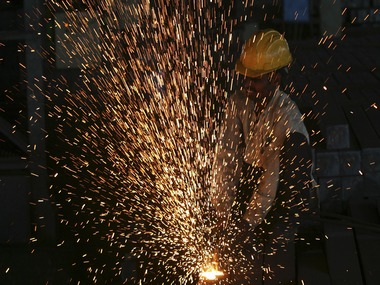Confidence, it seems, is increasingly in short supply around the globe. From businesses to consumers, everyone has been gripped by fears of a global recession, which has slowed manufacturing activity worldwide and sent consumer confidence tumbling to near-2008 lows.
Let’s consider manufacturing first: global manufacturing activity came perilously close to a near-halt in August, with new orders declining for the second month running, according to the Global Manufacturing PMI (purchasing managers index) compiled by JP Morgan. The index, which has fallen in the past six months, tumbled to 50.1 from 50.7 in July, marking its lowest reading since June 2009.A reading below 50 indicates a contraction in manufacturing activity, while a reading above that level indicates expansion.
[caption id=“attachment_75357” align=“alignleft” width=“380” caption=“Consumer confidence - a leading economic indicator - has been tumbling across most key regions. Reuters”]
 [/caption]
[/caption]
The crawl was reflected even in the manufacturing indices of individual countries. In the US, for instance, the Institute of Supply Management Index- a gauge of manufacturing activity- edged lower to 50.6 in August from 50.9 in July, although it was still better than what most economists had anticipated. Across the Atlantic, the overall eurozone purchasing managers index tumbled to 49 in August from 50.4 in July, according to data services Markit, indicating contraction.
France, Italy, Ireland, Spain and Greece posted readings below the contraction level of 50 while Germany’s manufacturing sector barely nudged ahead with an index reading of 50.9. It was the sector’s slowest pace of growth in two years, according to media reports.
Here in Asia, the manufacturing slump was evident in major economies as well. South Korea and Taiwan- two economies highly dependent on global trade - posted factory output index readings below 50 in August, indicating contraction. China’s manufacturing index also barely managed to stay above 50. In India too, the factory sector expanded at its slowest pace since March 2009 to 52.6 in August, according to the HSBC Markit India Manufacturing PMI. The index stood at 53.6 in July.
So, what’s happening here? Well, the biggest reason for the global manufacturing slump is that demand for new orders - from local or overseas consumers - has weakened. Growing fears over a darkening economic and jobs outlook is threatening to prompt consumers into firmly shutting their wallets.
Indeed, consumer confidence - a leading economic indicator - has been tumbling across most key regions: in the US, two widely watched consumer sentiment indices - the Reuters/University of Michigan Consumer Sentiment Index and the Consumer Board’s Consumer Confidence Index - dropped to their lowest levels in more than two years in August. In fact, the Reuters/University of Michigan index plunged to its lowest level since November 2008.
In Europe, the European Union’s economic sentiment index for the same month fell to 98.3 from 103 in July, driven by falls in industrial, service and consumer sentiment - the latter reported its sharpest drop in more than 20 years. In Asia too, in countries like India, falling auto and consumer goods sales offer evidence of cooling demand.
Clearly, no one is escaping the gloom. Asian economies have been hit by the weakness in developed nations, which are among the top buyers of their exports, while developed economies - already facing subdued local demand - have suffered because of slowing demand for their goods in emerging economies, which have struggled with high interest rates and high inflation for most of the year.Indeed, the weakness of one group of nations (developed or emerging) is reinforced by the weakness of the other group.
The slowdown in manufacturing activity and slump in consumer confidence will have significant implications for policy makers worldwide. To fight lower demand at home, companies have been depending on exports to boost factory activity. Unfortunately, that strategy might no longer help. One possibility is that nations could become more combative in global trade.
As the Wall Street Journal notes, the need to hold on to customers and preserve jobs could prompt countries to adopt protectionist measures or devalue their currencies. “The risk is that the revival in demand that everyone wants will be delayed by the very moves taken to protect market share. When the pie is shrinking, every nation will scramble to protect its slice,” it said.
Low growth and low confidence in future, no doubt, make for a highly toxic mix. One thing’s for sure: expect more hazardous times ahead.
)